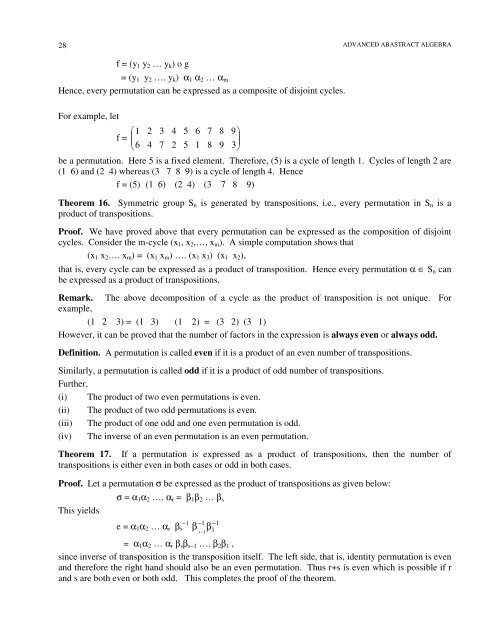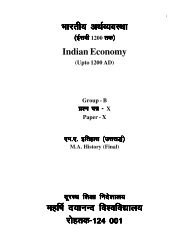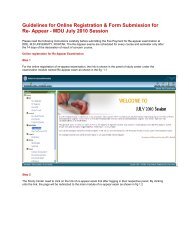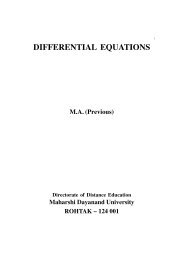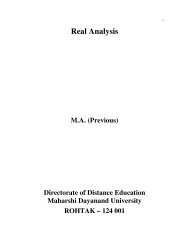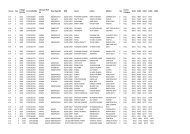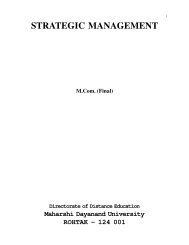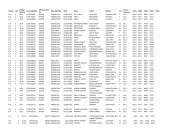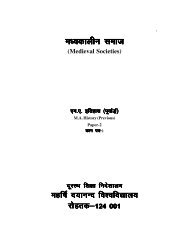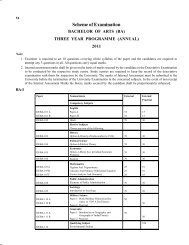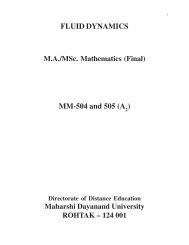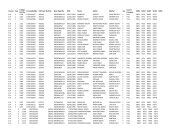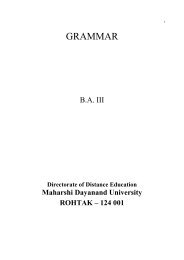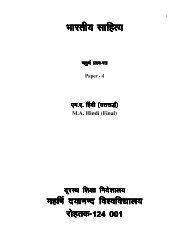Advanced Abstract Algebra - Maharshi Dayanand University, Rohtak
Advanced Abstract Algebra - Maharshi Dayanand University, Rohtak
Advanced Abstract Algebra - Maharshi Dayanand University, Rohtak
Create successful ePaper yourself
Turn your PDF publications into a flip-book with our unique Google optimized e-Paper software.
28<br />
ADVANCED ABASTRACT ALGEBRA<br />
f = (y 1 y 2 … y k ) o g<br />
= (y 1 y 2 …. y k ) α 1 α 2 … α m<br />
Hence, every permutation can be expressed as a composite of disjoint cycles.<br />
For example, let<br />
1<br />
f =<br />
<br />
6<br />
2<br />
4<br />
3<br />
7<br />
4<br />
2<br />
5<br />
5<br />
6<br />
1<br />
7<br />
8<br />
8<br />
9<br />
9<br />
<br />
3<br />
be a permutation. Here 5 is a fixed element. Therefore, (5) is a cycle of length 1. Cycles of length 2 are<br />
(1 6) and (2 4) whereas (3 7 8 9) is a cycle of length 4. Hence<br />
f = (5) (1 6) (2 4) (3 7 8 9)<br />
Theorem 16. Symmetric group S n is generated by transpositions, i.e., every permutation in S n is a<br />
product of transpositions.<br />
Proof. We have proved above that every permutation can be expressed as the composition of disjoint<br />
cycles. Consider the m-cycle (x 1 , x 2 ,…, x m ). A simple computation shows that<br />
(x 1 x 2 …. x m ) = (x 1 x m ) …. (x 1 x 3 ) (x 1 x 2 ),<br />
that is, every cycle can be expressed as a product of transposition. Hence every permutation α ∈ S n can<br />
be expressed as a product of transpositions.<br />
Remark. The above decomposition of a cycle as the product of transposition is not unique. For<br />
example,<br />
(1 2 3) = (1 3) (1 2) = (3 2) (3 1)<br />
However, it can be proved that the number of factors in the expression is always even or always odd.<br />
Definition. A permutation is called even if it is a product of an even number of transpositions.<br />
Similarly, a permutation is called odd if it is a product of odd number of transpositions.<br />
Further,<br />
(i) The product of two even permutations is even.<br />
(ii) The product of two odd permutations is even.<br />
(iii) The product of one odd and one even permutation is odd.<br />
(iv) The inverse of an even permutation is an even permutation.<br />
Theorem 17. If a permutation is expressed as a product of transpositions, then the number of<br />
transpositions is either even in both cases or odd in both cases.<br />
Proof. Let a permutation σ be expressed as the product of transpositions as given below:<br />
This yields<br />
σ = α 1 α 2 …. α r = β 1 β 2 … β s<br />
−1<br />
e = α 1 α 2 … α r β − 1 1<br />
s β −<br />
β<br />
r − 1<br />
1<br />
= α 1 α 2 … α r β s β s−1 …. β 2 β 1 ,<br />
since inverse of transposition is the transposition itself. The left side, that is, identity permutation is even<br />
and therefore the right hand should also be an even permutation. Thus r+s is even which is possible if r<br />
and s are both even or both odd. This completes the proof of the theorem.


